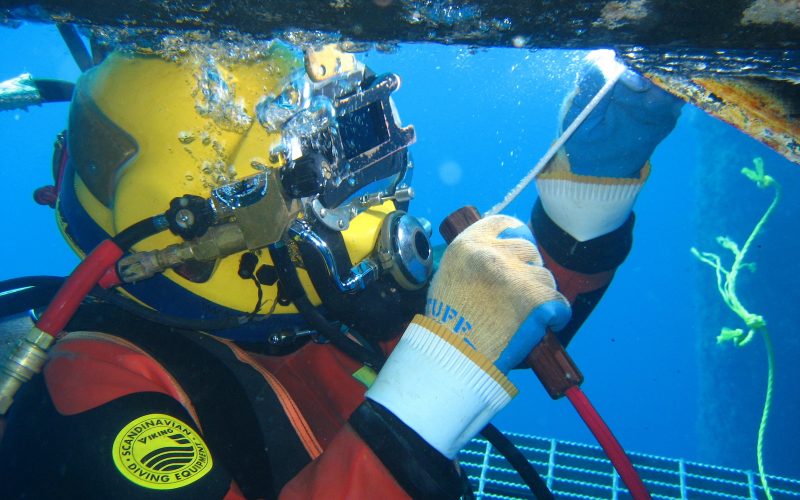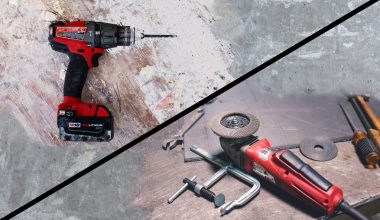Underwater welding is a very dangerous occupation. There are a lot of factors that impact the risk, as well as the high salary that comes with it. On top of that, underwater welders need to be very skilled at both diving and welding.
There are many hazards involved that we will be covering here. If you are interested in learning more on the topic, be sure to keep reading.
What type of welding is Used underwater?
Underwater welding is different from welding on dry land as the water is conductive and surrounds the metal. Therefore Mig welding and Tig welding are not options for underwater welders. Instead, they use SMAW, also known as stick welding. this is a type of Arc welding that requires a lot of skill even when on dry land!
What are the Risks with Underwater Welding
There are many risks involved. To be an underwater welder, you need to have completed intense training and have mastered a unique skillset. However, the job can lead to complicated health problems or even fatal accidents.
The following are the risks you will want to be familiar with.
Explosions
With underwater welding, there is an increased risk of explosions. This is because hydrogen and oxygen can form gas pockets easily. If they are ignited, they can cause an explosion. If you hear a “pop” that means that the gases are gathering and forming pockets.
You will need to stop welding right away to avoid injury. If you can, you will want to find where the gases are collecting, so you can avoid the area. Do not restart welding, as it is very dangerous.
Electrocution
If the welding equipment is not properly designed for use underwater, electric currents can easily travel to you, causing a lot of harm. All equipment needs to be thoroughly insulated and tested before use at the site.
The risk of shock is actually much higher in fresh water than it is in salt water. This is due to the direction of your arc being less stable- it requires experience and skill to control without risk.
Decompression Sickness
This condition is also known as the bends. This happens when you rise to the surface of the water too quickly, without allowing time for your body to decompress back to normal pressure. Decompression sickness causes pain in your joints and muscles.
It can also cause cramps, numbness, nausea, and even paralysis in some circumstances. To avoid it, you will need to wait in certain pressure zones before ascending.
Hypothermia
When the water is too cold, you could easily experience hypothermia. This leads to many complications within the body. However, it can be avoided by wearing the proper insulated equipment.
Pressure Damage
Spending too long underwater can cause damage to your body. In particular, your ears and lungs. Hearing impairment is a common issue and it can last a long time or go away not too long after resurfacing.
Differential Pressure
Differential pressure is a phrase that many divers are familiar with. It refers to the water flow hazard that comes from two different water levels meeting. The difference in pressure creates a space where water is moving with a large amount of power behind it.
It is extremely dangerous, as it is impossible to see- and very difficult to escape from. The pressure can even go up to hundreds of pounds per square inch. This leads to a risk of drowning if you are trapped, as well as hypothermia having a chance to set in.
Advancing Technology
However, each day underwater welding is becoming more safe with advancing technology. Robots and better equipment are being created to further protect divers. It is a very demanding job, but technology is starting to make it safer for people to do.
Why Choose Underwater Welding
Despite the many risks, there are a lot of benefits that make many people consider this as their career. The aspect that draws in people the most, is that you can make a lot of money, in a short amount of time. Often, divers are paid their entire salary in just a few months.
Plus, welding is necessary for industries to build and grow- including underwater welding. The job is in very high demand. Even though the technology is advancing, it is impossible for robots to complete the task with the precision that humans can. It is given only an 18% chance of being replaced by robots.
Overall, this is a challenging form of work that pays off very quickly. Many welders become interested right away due to the large salaries. Workers in this field need to be very skilled in both diving and welding, so the career does require a large amount of training.
Underwater Welding in Conclusion
Underwater welding is a complex task. The job requires that you have met all the diving and welding requirements, leading to a lot of training. You will also need to learn all of the safety protocols and be very familiar with them.
In short, underwater welding is dangerous. However, those that do it feel that it is rewarding in many different ways.







1 comment
It really helped when you talked about underwater welding and how it comes with financial benefits. Recently, one of my cousins said he’s interested in becoming a welder. My cousin would like to specialize in a specific area, and since he does enjoy the sea, he’d like the idea of working underwater! Thanks for the advice on underwater welding and how it’s very profitable!